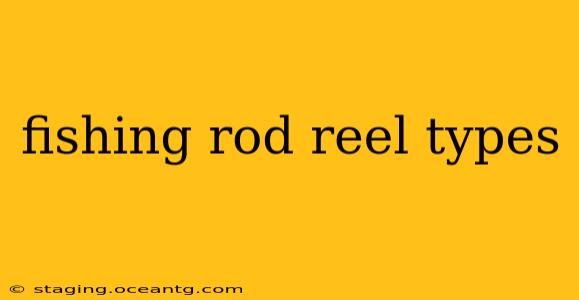Choosing the right fishing reel can significantly impact your angling success. With a dizzying array of options available, understanding the different types of fishing rod reels is crucial for any angler, whether you're a seasoned pro or just starting out. This guide breaks down the major reel categories, helping you select the perfect match for your fishing style and target species.
What are the Different Types of Fishing Reels?
The primary types of fishing reels fall into several distinct categories, each designed with specific fishing techniques and target species in mind. These include spinning reels, baitcasting reels, spincast reels, and fly reels. Let's delve into each one:
Spinning Reels
Spinning reels are arguably the most popular type among anglers, particularly beginners. Their simplicity and ease of use make them ideal for a variety of freshwater and saltwater fishing applications. The spool rotates freely, allowing for smooth casting and retrieving. They're excellent for light to medium-weight lures and baits, making them versatile for targeting a range of fish.
Advantages:
- Ease of use: Simple to learn and operate, making them great for beginners.
- Smooth casting: The free-spinning spool allows for long, accurate casts.
- Versatility: Suitable for a wide range of fishing techniques and species.
- Relatively inexpensive: Many affordable options are available.
Disadvantages:
- Line twist: Can be prone to line twist if not properly maintained.
- Not ideal for heavy lures: Not as powerful as baitcasting reels for heavier applications.
Baitcasting Reels
Baitcasting reels are favored by anglers targeting larger game fish or using heavier lures. These reels feature a level-wind system that neatly lays the line onto the spool, minimizing line tangles. They offer superior casting distance and control, but require more skill and practice to master. The learning curve is steeper than spinning reels due to the potential for backlash (bird nests).
Advantages:
- Powerful: Excellent for handling heavy lures and larger fish.
- Long casting distance: Provides greater control and accuracy in casting.
- Strong drag system: Crucial for fighting powerful fish.
Disadvantages:
- Steeper learning curve: Requires practice to avoid backlash.
- Can be more expensive: High-quality baitcasting reels can be costly.
- More maintenance: Requires more frequent cleaning and maintenance.
Spincast Reels
Spincast reels are the simplest type of fishing reel, often found on inexpensive fishing rods. They are enclosed, protecting the internal mechanisms from the elements. Their ease of use makes them a popular choice for beginners and children. However, their casting distance and control are often limited.
Advantages:
- Simple to use: Extremely easy to learn and operate.
- Durable: Enclosed design protects internal components.
- Affordable: Generally the least expensive reel type.
Disadvantages:
- Limited casting distance: Not ideal for long casts.
- Less control: Offers less control over the line compared to spinning or baitcasting reels.
- Not ideal for larger fish: Not powerful enough for larger game fish.
Fly Reels
Fly reels are specifically designed for fly fishing, a specialized technique using lightweight artificial flies. They are built for quick retrieval and storage of the fly line, which is crucial in fly fishing. Fly reels are less about the power of the retrieve and more about managing the line effectively during casting and the fight.
Advantages:
- Lightweight: Designed to minimize weight for optimal casting.
- Smooth drag system: Essential for delicate handling of fish and line management.
- Efficient line retrieval: Facilitates quick retrieval of the line after casting.
Disadvantages:
- Specialized use: Only suitable for fly fishing.
- Can be expensive: High-quality fly reels are often quite costly.
- Requires specific techniques: Fly fishing requires a different skill set than other types of fishing.
What Type of Reel is Best for Beginners?
For beginners, spinning reels are generally recommended. Their ease of use and versatility make them an excellent starting point. They are forgiving, allowing you to focus on learning the fundamentals of casting and retrieving without the complexities of baitcasting reels.
What is the Difference Between a Spinning Reel and a Baitcasting Reel?
The key differences lie in their design, casting mechanism, and applications. Spinning reels utilize a rotating spool and are easier to use, while baitcasting reels feature a level-wind system for more precise casting but require more skill to avoid tangles. Spinning reels are generally better for lighter lures and applications, whereas baitcasting reels excel with heavier lures and bigger fish.
Which Reel is Best for Bass Fishing?
Both baitcasting and spinning reels are popular choices for bass fishing, depending on the technique and lure used. Baitcasting reels offer better accuracy and power for heavier lures, while spinning reels are better suited for lighter lures like crankbaits and finesse jigs.
What is the Best Reel for Saltwater Fishing?
The best reel for saltwater fishing depends on the target species and fishing conditions. However, strong, corrosion-resistant reels are crucial. Both spinning and baitcasting reels are used, with the choice often determined by the type of fishing and the size of the fish targeted. Proper saltwater maintenance is essential to extend the lifespan of any saltwater fishing reel.
This guide provides a comprehensive overview of the various fishing reel types. Remember to consider your fishing style, target species, and budget when making your selection. Happy fishing!
